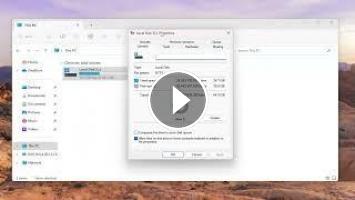How to Enable or Disable Disk Write Caching in Windows 11 [Tutorial]
Disk Write Caching is a feature that improves system performance by enabling write caching on the device. It is a feature, which is available on almost all disk drives these days. The benefit of Disk Write Caching is that it allows applications to run faster by allowing them to proceed without waiting for data write-requests to be written to the disk.
Let’s say you save a file. Now when you save it, Windows makes a note that you want to save the file on your hard drive. This information is saved temporarily in Windows memory, and it will write this file to the hard drive later on. After the file is written to the hard drive, the cache will send an acknowledgment to Windows 10/8/7 that the file has been written to the hard drive and it can now be safely removed from the cache.
Issues addressed in this tutorial:
enable or disable write caching SSD
enable write caching on the device windows 11
enable write caching windows 10
windows enable write caching on the device
cannot enable write caching on the device
how to enable write caching windows 11
windows enable write caching
should i disable write caching windows 10
windows 10 enable write caching on the device
can't enable write caching on the disk
disable write caching windows 11
enable write caching on the device
This tutorial will apply for computers, laptops, desktops, and tablets running the Windows 10 and Windows 11 operating systems (Home, Professional, Enterprise, Education) from all supported hardware manufactures, like Dell, HP, Acer, Asus, Toshiba, Lenovo, Alienware, Razer, MSI, Huawei , Microsoft Surface, and Samsung.
Disk Write Caching is a feature that improves system performance by enabling write caching on the device. It is a feature, which is available on almost all disk drives these days. The benefit of Disk Write Caching is that it allows applications to run faster by allowing them to proceed without waiting for data write-requests to be written to the disk.
Let’s say you save a file. Now when you save it, Windows makes a note that you want to save the file on your hard drive. This information is saved temporarily in Windows memory, and it will write this file to the hard drive later on. After the file is written to the hard drive, the cache will send an acknowledgment to Windows 10/8/7 that the file has been written to the hard drive and it can now be safely removed from the cache.
Issues addressed in this tutorial:
enable or disable write caching SSD
enable write caching on the device windows 11
enable write caching windows 10
windows enable write caching on the device
cannot enable write caching on the device
how to enable write caching windows 11
windows enable write caching
should i disable write caching windows 10
windows 10 enable write caching on the device
can't enable write caching on the disk
disable write caching windows 11
enable write caching on the device
This tutorial will apply for computers, laptops, desktops, and tablets running the Windows 10 and Windows 11 operating systems (Home, Professional, Enterprise, Education) from all supported hardware manufactures, like Dell, HP, Acer, Asus, Toshiba, Lenovo, Alienware, Razer, MSI, Huawei , Microsoft Surface, and Samsung.
- Category
- World Tutorials Country A - L World Tutorials Country N - T
- Tags
- dell, hp, acer














Comments